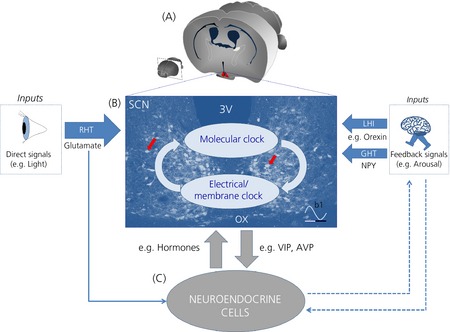Figure 2.

Cross‐talk between the suprachiasmatic nucleus (SCN) and neuroendocrine cells. (a) Cross‐section of the mouse brain at the anatomical level of the SCN (in red). (b) Bidirectional communication between the molecular clock (transcription–translation molecular feedback loop; TTFL) and electrical/membrane clock. In this model, the TTFL clock drives day–night rhythms in the electrical activity of SCN neurones, and electrical activity feedback onto the TTFL clock through unknown mechanisms (light blue arrows). This may underlie how the TTFL outputs signals to neuroendocrine cells (c) and how neuroendocrine processes feedback to adjust circadian timing in the SCN (grey arrows). This drawing is superimposed on top of a modified image taken at the SCN mid‐coronal section showing Per1‐EGFP neurones (red arrows). Darker blue arrows represent inputs to the SCN, with their sizes denoting feedback magnitude. Solid arrows indicate an established link, whereas broken arrows show tentative interactions. (b1) Stylised waveform showing daily variation in SCN Per1 and electrical activity. White and black bars underneath represent day and night, respectively. RHT, retino‐hypothalamic tract; LHI, lateral hypothalamic input; GHT, geniculo‐hypothalamic tract; OX, optic chiasm; 3V, third ventricle; NPY, neuropeptide Y; VIP, vasoactive intestinal polypeptide; AVP, arginine vasopressin.
